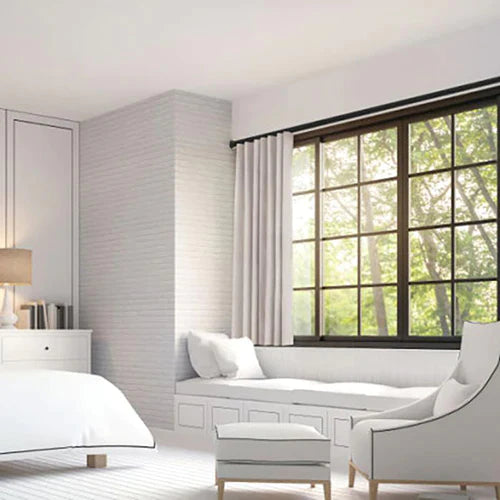Ripplefold drapery is currently one of the most popular drapery styles. Ripplefold drapery panels differ greatly from other types of window treatments including pinch pleat drapery panels, not only in the style but also in installation.

What is Ripplefold drapery?
A bird’s-eye view drawing of a Ripplefold drapery panel looks a bit like a sound wave. The undulating, serpentine folds in the panel present a soft ripple effect that maintains its shape as the drapery opens and closes.
A good analogy for this idea is the interior of an accordion. The folds in the body of the instrument allow a musician to open and close the interior of the instrument as needed. When the instrument is closed, the folds in the material “scrunch” in the way the S-curve of the Ripplefold drapery does when the drapes are pulled to the side. When the instrument is open, the material flattens slightly but the folds remain; just as the drapery will maintain folds when the panels are closed.
Ripplefold Drapery Hardware: What Kind of Hardware Does Ripplefold Drapery Require?
To maintain a consistent S-fold design, Ripplefold draperies require a specific kind of hardware that supports the structure of the panels.
Hardware, like Kirsch Architrac and Estate Ripplefold Drapery Rods, consists of a track with snap carriers along the lower edge. The snap carriers function much like drapery pins. Snap tape is sewn to the top of a Ripplefold drapery panel attach to these carriers instead of drapery pins to hold the window treatment to the rods.
The carriers and snap tape work together to create the iconic S-fold or “ripple” that gives this type of treatment its name. It is this combination of hardware and snap tape on a ceiling or wall-mounted track which allows the drapery to open and close.
Like all traverse rods, you may choose either a cord or a baton to move the panels. A cord-drawn rod uses a pulley system to move the drapery. On the other hand, a baton hook directly to the rod’s master carriers and allows the user to pull the drapes open and closed manually.
At the lead edge of each Rpplefold drapery panel is a master carrier. It is this piece of hardware that moves all of the other snap hardware much like a locomotive pulls the cars of a train. There are two types of master carriers available for Ripplefold Drapery Rods.
The first type, called the overlap master carrier, is particularly helpful if you need light control on center open/split draw rods. With this master carrier, the panels will flatten out to “overlap” in the middle of the rods with one panel lapping over the other.
A butt-master carrier also allows the folds of the drapery panel to “return” to the wall. These carriers are generally best suited for one-way draw drapery rods. They lessen the light gap at the opening end of the rod and continue the flow of the drapery to the end of the panel. Butt-master carriers can be used with center open rods but, because there is no overlap, there may be a slight gap in the center.
Ripplefold drapery looks great in modern-style homes, such as California contemporary but they also work well with transitional and casual styles. Unlike ruffled, rod pocket drapery, Ripplefold drapery looks clean and smooth. Whether you gravitate toward industrial-style designs or farmhouse simplicity, this streamlined, no-fuss look will be perfect for you.
Finally, due to their heavy-duty design, Ripplefold drapery, and more specifically, the hardware that goes with them, is a great option for commercial buildings. The tracks are sturdy enough to be opened and closed multiple times a day, without looking droopy or worn out which is one of the reasons hotels rely so heavily on this type of window treatment.
If you have more questions about ripplefold drapery panels or the hardware that works best with them, feel free to contact us today.
